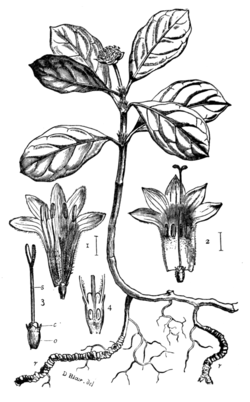1911 Encyclopædia Britannica/Rubiaceae
RUBIACEAE, in botany, a large natural order of seed plants, belonging to the series Rubiales of the subclass Sympetalae (Gamopetalae) of Dicotyledons, and containing about 3 50 genera with about 4 500 species. It is mainly a tropical family of trees, shrubs and herbs, but some of the tribes, especially Galieae, to which the British representatives belong and which contains only herbs, are more strongly developed in temperate regions;. some species of Galium reach the Arctic zone and are found at high elevations on mountains in the tropics. The most striking characteristic of the family are the' opposite decussate, generally entire, stipulate leaves. The stipules are very varied in form; they generally stand between the petioles of a pair of leaves (interpetiolar). The two stipules of adjacent leaves are usually united, and in the Galieae, as well shown in the British species, are enlarged and leaf-like, forming with the two leaves an apparent whorl; by fusion or branching of the stipules the number of leaves in the whorl varies from four to eight or more. The flowers are rarely solitary, terminal or axillary, as in Gardenia; generally they are arranged in cymes or panicles or crowded into heads, and are often showy; in British members of the family they are very small, but may be conspicuous from their numbers, as in lady's bedstraw (Galium verum). The flowers are hermaphrodite and regular with parts in fours or fives; the four or five sepals, petals and stamens are placed above the ovary, which consists of two carpels, contains one to indefinite anatropous ovules in each of the two chambers, and is crowned by a simple style ending in a head or in two lobes. The sepals are often small, sometimes reduced to a narrow ring encircling the top of the ovary or altogether absent. The united petals form a corolla which varies widely in form in the different genera; it is often funnel- or salver-shaped, the honey, which is secreted by a disk round the base of the style, being at the bottom of a longer or shorter tube, in which case the flowers are adapted for pollination by Lepidoptera or bees, as in Gardenia, Mussaenda, Guetlarda, &c.; in other cases it is bell-shaped or, as in Galium, rotate, with a short tube and sharply spreading segments; the honey is in these cases freely exposed or only slightly concealed and the flowers are pollinated by flies. The stamens are attached to the corolla-tube and alternate in position with its segments; the flowers are often dimorphic (or hetero styled) with short-styled and long-styled forms as in ipecacuanha (see f1g.). The fruit also varies widely in form and is dry or fleshy. When dry it forms a capsule with septicidal or loculicidal dehiscence, or is a schizo carp separating when dry into two one-seeded mericarps which, as in the British cleavers (Galium A parine), sometimes bear hooked appendages which aid their dispersal. Some genera show a remarkable association with ants. Thus Myrmecodia, Hydnophytum are epiphytic plants, in which the base of the stem forms a large tuber, which is attached to the support by numerous adventitious roots. The substance of the tuber is pene» trated by numerous cork-lined cavities communicating by galleries, which are inhabited by ants. There is no evidence that the presence of the ants is of any service to the plant. The order is divided into a large number of tribes based on the number of ovules in each ovary-chamber, the character of the fruit seed and ovule, and the aestivation of the corolla. These may be arranged in three families as follows: Cinchoneae, often woody plants with scale-like stipules, and numerous ovules in each ovary-chamber; the fruit is generally a capsule. To this belong Cinchona (q.v.), a genus of large trees with handsome flowers containing about forty species in the Andes of South America-it is well known as the source of Peruvian bark. An allied genus, Bouvardia (q.'u.), from tropical America, is cultivated for its flowers. The species of Uncaria climb by means of hooks which are modified inflorescence-axes.
Mussaenda, Gardenia (q.v.), and other genera are characterized by having a fleshy fruit.-Cofeeae,
often woody or shrubby plants with scale-like stipules; each ovary-chamber contains only one ovule. Cofee (q.v.), a genus of shrubs with about twenty-five species in the Old World tropics, includes the coffee plant (C. arabica and C. liberica); the fruit is a two-seeded drupe, the seed is the " coffee-bean." The thickened root of Uragoga ipecacuanha yields ipecacuanha (q.11.). Stellateae, herbaceous plants with leaf-like stipules; each ovary chamber contains one ovule only. Includes the four British genera Rubia, one species of which, R. linclorum, is madder; Galium, including G. verum (lady's bedstraw), G. Aparine (goose-grass or cleavers), and other British species; Asperula, including A. odorala (Woodruff) and Sherardia.
The order is closely allied to Caprifoliaceae, the chief distinction being the absence of stipules in the latter.

Ipecacuanha Plant.
